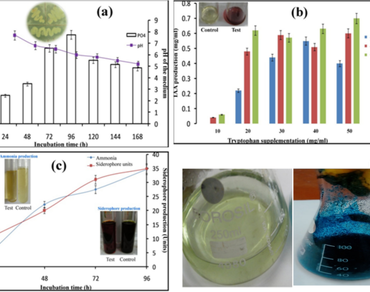Bacillus wiedmanni SAB10, a hidden hero as plant probiotics: assessment of its potential on the growth of Amaranthus viridis
*Article not assigned to an issue yet
Research Articles | Published: 24 April, 2025
First Page: 0
Last Page: 0
Views: 473
Keywords: n Amaranthus viridisn , n Bacillus wiedmannin SAB10n , Plant growth promoting rhizobacteria, Root colonization, Secondary metabolites
Abstract
This study was navigated to examine the effectiveness of Bacillus wiedmanni SAB10 as a plant growth-promoting rhizobacteria (PGPR) that produced secondary metabolites for enhancement of growth, and recycling of essential nutrients. Bacterial strain was examined for non-symbiotic nitrogen fixation, indole- 3-acetic acid production, tri-calcium-phosphate solubilization, ammonia production, siderophore production and biofilm production. The seed application of bacterial strain promoted the overall dry biomass of Amaranthus viridis by 11.57% and overall length by 75.43% after 30 days of showing as compared to non-treated controls and its growth performance was similar to inorganic fertilizer applied plants. From this study it was concluded that Bacillus wiedmanni SAB10 is an effective plant probiotic that can colonize on the root and liberate active metabolites which exerted beneficial effects for the growth of Amaranthus viridis.

References
Bal HB, Das S, Dangar TK, Adhya TK (2013) ACC deaminase and IAA producing growth promoting bacteria from the rhizosphere soil of tropical rice plants. J Basic Microbiol 53(12):972–984
Branda SS, Chu F, Kearns DB, Losick R, Kolter R (2006) A major protein component of the Bacillus subtilis biofilm matrix. Mol Microbiol 59(4):1229–1238
Bric JM, Bostock RM, Silverstone SE (1991) Rapid in situ assay for indoleacetic acid production by bacteria immobilized on a nitrocellulose membrane. Appl Environ Microbiol 57(2):535–538
Cao M, Narayanan M, Shi X, Chen X, Li Z, Ma Y (2023) Optimistic contributions of plant growth-promoting bacteria for sustainable agriculture and climate stress alleviation. Environ Res 217:1-13
Elmerich C (2007) Historical perspective: from bacterization to endophytes. Associative and endophytic nitrogen-fixing bacteria and cyanobacterial associations Springer, Dordrecht, pp 1–20
Geetha K, Rajithasri AB, Bhadraiah B (2014) Isolation of Plant growth promoting rhizobacteria from rhizosphere soils of green gram, biochemical characterization and screening for antifungal activity against pathogenic fungi. Int J Pharm Sci Invent 3(9):47–54
Ghosh P, Rathinasabapathi B, Teplitski M, Ma LQ (2015) Bacterial ability in AsIII oxidation and AsV reduction: relation to arsenic tolerance, P uptake, and siderophore production. Chemosphere 138:995–1000
Glick BR (1995) The enhancement of plant growth by free-living bacteria. Can J Microbiol 41(2):109–117
Goswami D, Patel K, Parmar S, Vaghela H, Muley N, Dhandhukia P, Thakker JN (2015) Elucidating multifaceted urease producing marine Pseudomonas aeruginosa BG as a cogent PGPR and bio-control agent. Plant Growth Regul 75:253–263
Gray EJ, Smith DL (2005) Intracellular and extracellular PGPR: commonalities and distinctions in the plant–bacterium signaling processes. Soil Biol Biochem 37(3):395–412
Haas D, Défago G (2005) Biological control of soil-borne pathogens by fluorescent pseudomonads. Nat Rev Microbiol 3(4):307–319
He S, Li L, Lv M, Wang R, Wang L, Yu S, Li X (2024) PGPR: key to enhancing crop productivity and achieving sustainable agriculture. Curr Microbiol 81(11):1–17
Idris EE, Iglesias DJ, Talon M, Borriss R (2007) Tryptophan-dependent production of indole-3-acetic acid (IAA) affects level of plant growth promotion by Bacillus amyloliquefaciens FZB42. Mol Plant Microbe Interact 20(6):619–626
Indiragandhi P, Anandham R, Madhaiyan M, Kim GH, Sa T (2008) Cross-utilization and expression of outer membrane receptor proteins for siderophore uptake by Diamondback moth Plutella xylostella (Lepidoptera: Plutellidae) gut bacteria. FEMS Microbiol Lett 289(1):27–33
Jacobson CB, Pasternak JJ, Glick BR (1994) Partial purification and characterization of 1-aminocyclopropane-1-carboxylate deaminase from the plant growth promoting rhizobacterium Pseudomonas putida GR12-2. Can J Microbiol 40(12):1019–1025
Jha CK, Patel D, Rajendran N, Saraf M (2010) Combinatorial assessment on dominance and informative diversity of PGPR from rhizosphere of Jatropha curcas L. J Basic Microbiol 50(3):211–217
Kloepper JW, Schroth MN (1981) Plant growth-promoting rhizobacteria and plant growth under gnotobiotic conditions. Phytopathology 71(6):642–644
Lebuhn M, Heulin T, Hartmann A (1997) Production of auxin and other indolic and phenolic compounds by Paenibacillus polymyxa strains isolated from different proximity to plant roots. FEMS Microbiol Ecol 22(4):325–334
Musk DJ, Banko DA, Hergenrother PJ (2005) Iron salts perturb biofilm formation and disrupt existing biofilms of Pseudomonas aeruginosa. Chem Biol 12(7):789–796
Sivasubramanian P, Rajamathanky H, Ragupathi G, Rajesh V (2019) Pharmacognostical characteristics of Amaranthus viridis L. J Pharmacogn Phytochem 8(6):1949–1953
Spaepen S, Vanderleyden J, Okon Y (2009) Plant growth-promoting actions of rhizobacteria. Adv Bot Res 51:283–320
Sunar K (2013) Studies on soil microbial diversity of Darjeeling hills and their evaluation for utilization in the improvement of crop health (Doctoral dissertation, University of North Bengal).
Tank N, Saraf M (2003) Phosphate solubilization, exopolysaccharide production and indole acetic acid secretion by rhizobacteria isolated from Trigonella foenum-graecum. Indian J Microbiol 43(1):37–40
Vessey JK (2003) Plant growth promoting rhizobacteria as biofertilizers. Plant Soil 255:571–586
Zhao X, Zhao F, Wang J, Zhong N (2017) Biofilm formation and control strategies of foodborne pathogens: food safety perspectives. RSC Adv 7(58):36670–36683
Author Information
Department of Biotechnology, Maharaja Sriram Chandra Bhanja Deo University, Baripada, India